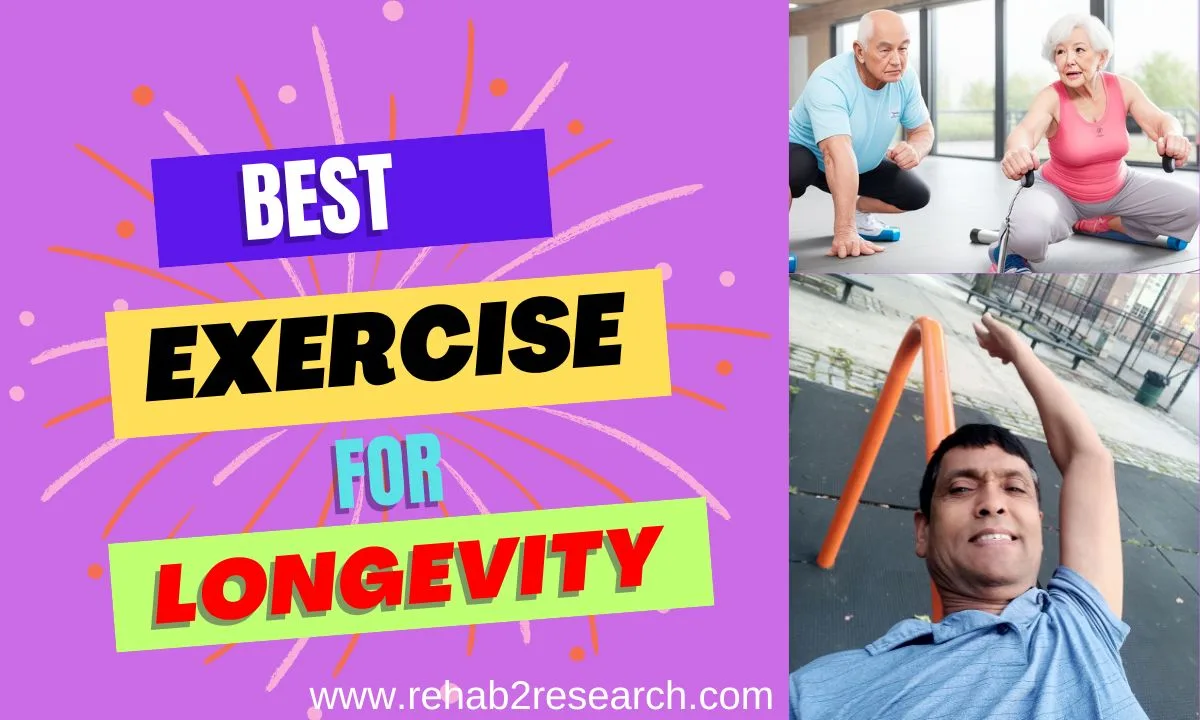Table of Contents
ToggleIntroduction
Best Exercise for Longevity: In pursuing longevity, the best exercise encompasses a holistic blend of cardiovascular activities, strength training, flexibility exercises, and mind-body practices. Cardiovascular exercises, like running or swimming, enhance heart health, while strength training preserves muscle mass crucial for aging bodies. Flexibility exercises like yoga improve mobility, and the mind-body connection fosters overall well-being. This comprehensive approach not only contributes to physical fitness but also addresses mental and emotional aspects, laying the foundation for a longer and healthier life. Embracing a varied exercise routine tailored to individual needs is the key to unlocking the secrets of longevity.
Exercise is a crucial pillar in the quest for a long and healthy life. Longevity, the art of living a longer and fuller life, is a goal many aspire to achieve. This article delves into the realm of longevity exercises, exploring the various forms that can contribute to a healthier and more extended lifespan.
Understanding Longevity
Understanding longevity requires unraveling the complex interplay of genetics, lifestyle, and environment. Regular exercise consistently emerges as a key factor in promoting a longer, fuller life. This exploration emphasizes the multifaceted aspects of longevity, highlighting exercise’s pivotal role. Before delving into specific exercises, it’s crucial to grasp the factors influencing longevity, including genetics, lifestyle choices, and environmental conditions. Despite these variables, regular exercise stands out as a consistent contributor. Let’s explore the impact of various exercise types on promoting overall well-being and an extended lifespan.
Cardiovascular Exercises

Cardiovascular exercises, often known as cardio, play a pivotal role in promoting heart health—a key factor in longevity. Engaging in activities like running, swimming, or cycling not only strengthens the heart but also improves circulation and stamina. These exercises help reduce the risk of cardiovascular diseases, contributing significantly to a longer life.
Strength Training for Longevity
Building and maintaining muscle mass is not just about aesthetics; it’s a crucial aspect of longevity. Strength training exercises, such as weightlifting or bodyweight exercises, help preserve bone density and muscle mass. As we age, this becomes increasingly important, as it can prevent frailty and enhance overall well-being.
Flexibility and Mobility Exercises
Maintaining flexibility is vital for aging individuals. It improves posture, reduces the risk of injuries, and enhances the range of motion. Incorporating exercises like yoga or Pilates into your routine promotes flexibility and mobility, contributing to a more agile and active lifestyle.
Mind-Body Connection
Exercise is not just a physical issue. It’s also a matter of the heart. Incorporating mindfulness into physical activity, such as yoga, not only enhances mental well-being but also contributes to longevity. The holistic approach of connecting mind and body fosters a healthier and more balanced life.
Balanced and Nutrient-Rich Diet

While exercise is a cornerstone of longevity, it should be complemented by a balanced and nutrient-rich diet. Consuming foods rich in antioxidants, omega-3 fatty acids, and essential vitamins supports overall health and longevity.
Hydration for Longevity
Adequate hydration is often overlooked, but essential for overall health. Proper hydration supports bodily functions, aids digestion, and contributes to healthier skin. These factors, in turn, play a role in longevity.
Quality Sleep
The relationship between sleep and longevity is undeniable. Good sleep allows the body to repair and regenerate. Establishing good sleep hygiene and addressing sleep-related issues contribute significantly to a longer and healthier life.
Social Engagement and Longevity
Loneliness and isolation can have negative effects on health Social engagement and maintaining strong connections with friends and family are linked to increased longevity. Activities that foster social interaction should be an integral part of a longevity-focused lifestyle.
Best Exercise for Longevity
Avoiding Sedentary Lifestyle
In the modern age of technology, a sedentary lifestyle is a significant concern. Sitting for long periods is associated with various health problems. Simple lifestyle changes, like taking short breaks to move or incorporating standing desks, can combat the risks associated with extended periods of inactivity.
Regular Health Check-ups

Prevention is a key aspect of longevity. Regular health check-ups allow for the early detection of potential issues and proactive intervention. Monitoring and maintaining overall health contribute to a longer and healthier life.
Best Exercise for Longevity
Adapting Exercise for Different Ages
One size does not fit all when it comes to longevity exercises. It’s essential to tailor exercise routines to different life stages. Consider individual needs, capabilities, and any existing health conditions when planning and adapting exercise regimens.
Why it is important to adapt exercise to different age groups is a very important topic. The importance of exercise leads to leading a healthy life, but it is extremely important to adapt exercise to different age groups keeping in mind the different needs and limitations.
For children, playing and engaging themselves is an important part of exercise. Games and toys can help them accept exercise as a form of exercise. They should be encouraged to do some active activities throughout the day, such as playing in the park, cycling, or joining sports clubs.
For youth, exercise is important, along with the challenges of achieving it, but also maintaining solid mental health and fitness. They may show interest in activities like social sports, yoga, gardening or gym.
For adults, the importance of exercise lies in improving their physical condition, reducing anxiety, and increasing their ability to cope with lifestyle diseases. They may be advised to do yoga, walking, swimming or external or internal exercises for weight management as exercise.
Overall, it is important to adapt exercise to different age groups so that each person can improve their physical and mental health.
Myths and Facts About Longevity Exercises
Dispelling common myths is crucial for promoting informed choices. We debunk myths surrounding longevity exercises and provide evidence-backed facts. Understanding the truth about exercise and longevity is essential for making the right choices for a healthier lifestyle.
Best Exercise for Longevity
Conclusion:
The journey towards longevity involves a holistic approach. Regular exercise, coupled with a balanced diet, quality sleep, and social engagement, forms the foundation for a longer and healthier life. Embracing a proactive lifestyle that incorporates various forms of exercise tailored to individual needs is the key to unlocking the secrets of longevity.
In conclusion, the path to longevity intertwines with a multifaceted approach to exercise. A harmonious blend of cardiovascular activities, strength training, flexibility exercises, and mindful practices form the foundation for a longer, healthier life. Embracing these varied exercises tailored to individual needs unlocks the secrets to a fulfilling and extended lifespan.
You May Also Like:
FAQs
The best exercise for longevity is a combination of cardiovascular exercises, strength training, flexibility, and mind-body activities. Variety is key for overall health.
Yes, it’s never too late to start. Adapt your exercise routine based on your age, health condition, and preferences.
A balanced and nutrient-rich diet complements exercise for longevity. Both aspects work together to promote overall well-being.
Social engagement reduces feelings of loneliness and promotes mental well-being, contributing to a longer and healthier life.
Yes, strength training is essential for older adults to maintain muscle mass, bone density, and overall physical function.





